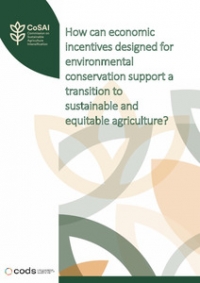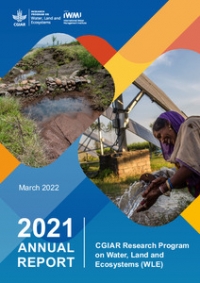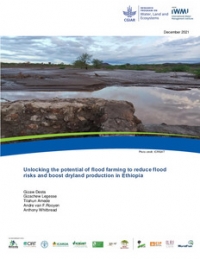The exponential growth of food demand, due to the increase of the world's population, has led to the expansion of agricultural activities. This has put enormous pressure on ecosystems worldwide, especially those in highly vulnerable areas such as mountainous regions, arid and semi-arid coastal zones, and tropical and sub-tropical forests. Combined with a rapidly changing climate, this issue has become increasingly complex and requires innovative scientific and technological approaches to be assessed, even including nuclear sciences.
Yes, I am sure that you are surprised. However, think about the last time you heard of nuclear sciences. Chances are that this was within a military context. This rather destructive view of nuclear sciences permeates common perceptions due to the extensive exploitation of nuclear technology for weapons production during the Cold War. Although the peaceful use of nuclear sciences has become more popular with applications in medicine (nuclear medicine) -- for diagnostic imaging, for instance -- its applications in many other fields, including agricultural research, are still largely unknown to the general public.
Let us start with an example that we may all remember from our days at high school -- plant growth and photosynthesis. Let me expand on that a little by explaining how this process is linked with nuclear sciences. It is all about isotopes. Isotopes are atoms of the same element which present different masses (such as 12C, 13C, 14C). Heavy and light isotopes behave differently so, for instance, biological systems incorporate isotopes differently as some biochemical reactions favour the uptake of specific isotopes and discriminate against others. This means that the isotopic composition of products and reagents of a given reaction may differ, a phenomenon known in scientific parlance as isotopic fractionation. Photosynthesis is perhaps the best known of such reactions, in which plants prefer to incorporate lighter carbon atoms (12C) in their biomass. Here we have an example of how nuclear sciences are present in our everyday lives! So we can see how their different properties mean that isotopes can give us clues to understand many environmental processes. We can therefore harness nuclear techniques for application in agricultural research for numerous and diverse studies, and on different scales -- from the level of individual organisms to entire regions and ecosystems.
So how can nuclear sciences assist in agricultural research? Here are three ways:
1. Boosting nutrition
The negative impact of illnesses connected with iron deficiency can be felt on the social and economic development of nations, especially in the global South. Indeed, in the developing world, conditions such as anaemia affect a staggering number of people, accounting for more than 89% of the global cases in 2013, including young children and pregnant women. The scenario has devastating consequences for public health and is a major challenge, so, to maximise effective solutions, it is paramount to address the problem from different perspectives. In this sense, there have been examples of targets being set as well as recommendations being proposed to achieve them, and a few of these recommendations are backed up by recent isotope research. For instance, by introducing stable isotopes of iron into rice fortificants and later measuring them in human blood cells, research has identified compounds for rice fortification with the potential to increase iron absorption by individuals from Ghanaian communities with a low dietary diversity that lacks key nutrients. The implications of these findings are important for promoting the recommended iron intake, thus reducing the prevalence of deficiency-related diseases.
2. Tracking environmental perturbations
It has been shown that the nitrogen cycle has been disturbed by human activities, such as food production, releasing a significant amount of this element into the environment.It would therefore be expected that, with increasing availability of nitrogen (N), plants would absorb more of it. On the contrary, recent research measuring nitrogen isotopes in leaves has suggested that the availability of N in ecosystems that are not subject to fertilization declined between 1980 and 2017 and that rising atmospheric CO2 levels are to blame. One of the possible explanations for this is that elevated CO2 levels lead to increases in the plant demand for N, which may then exceed N supply. Agriculture-related environmental perturbations such as land-use changes are also responsible for the loss of soil fertility, caused by the depletion of organic carbon in the soil, especially in the tropics and subtropics.
Scientists have measured stable isotopes of carbon, which has allowed for the identification of grass-like understories as effective contributors to restore soil fertility, lost due to agriculture in Cameroon.Soil erosion also brings a series of problems to agricultural practices, including the decrease of soil productivity. However, it is possible to measure the carbon isotopic composition of specific plant-derived compounds (e.g., fatty acids) present in the soil, in order to identify areas subjected to erosion. These isotopic ratios depend on the specific type of vegetation associated with land use and allow us to trace where the sediment, together with nutrients, is coming from. By discriminating sediment sources in a given location governments can target land managers that need assistance to better utilise soil resources.
As dry spells become longer, more frequent, and severe, it is important to secure food production in the most affected regions. A recent partnership between the International Institute of Tropical Agriculture (IITA) and the joint FAO/IAEA Division of Nuclear Techniques in Food and Agriculture seeks to minimize drought effects on cassava-based production systems in Central Africa.The project, called CIALCA (Consortium for Improving Agriculture-based Livelihoods in Central Africa), employs carbon isotopic measurements to assess water use efficiency by cassava plants. It works like this: recalling our photosynthesis example, the stable carbon isotope ratio of plant tissue reflects the environmental isotopic signature and thus will respond to parameters such as water availability. Therefore, by unlocking the relationship between the isotopic signal and environmental variables, it will be possible to identify adequate measures to improve water use efficiency and cassava resilience to climate change. Moreover, exaggeration in the use of fertilizers leads to environmental pollution with the contamination of the local watershed. A study performed in China has shown that this is the case for the Jiaozhou Bay area.The authors have measured stable isotopes of nitrogen and oxygen to conclude that the application of fertilizers in the local agricultural land is a major source of nitrate pollution, resulting in the occurrence of eutrophication processes in freshwater systems and impairing the biota and water quality.
3. Assessing climate change
A third, timely agriculture-related issue is the mitigation of climate change by reducing the emission of greenhouse gases by the agricultural sector, which has been shown to be a major contributor. A study involving the radioactive isotope of carbon (14C or radiocarbon) has revealed that the deforestation of a tropical forest in Congo has been remobilizing old soil organic matter. The removal of the original vegetation has exposed soil to erosion, releasing old carbon (14C-depleted) to the nearby river systems where it is eventually returned to the atmosphere. The destabilization of the massive carbon pool stored in tropical soils intensifies the greenhouse effect and represents a threat for ecosystems worldwide. Here, the isotope work helps to identify the source of carbon being released to the atmosphere as CO2. Indeed, it essentially tells us that even carbon sequestered in pools that have been isolated for a long time is being affected by our activities. Moreover, the overuse of nitrogen-based fertilizers contributes to the aggravation of the climate crisis. Indeed, the excessive use of these substances in the agricultural sector means that the leftovers, not absorbed by the crops, will undergo conversion into nitrous oxide (N2O). This makes the soil become a significant source of this potent greenhouse gas in the atmosphere. The magnitude of this problem can be influenced by irrigation methods such as drip and furrow irrigation. In China, a recent study has employed nitrogen stable isotopes measurements to conclude that drip irrigation works best to minimize N2O emissions from a vegetable field. Therefore, results from isotope research have the potential to help farmers to implement a reasonable amount of nitrogen-based fertilizer application in their land.
Looking to the future
Like any other advanced technology, nuclear techniques can be used for either peaceful or hostile purposes. These examples of recent research illustrate only a fraction of the agriculture-related concerns that can be investigated using nuclear techniques. Our current food production system presents several issues that need to be tackled to enable our transition into more sustainable agricultural practices. From an environmental point of view, many of these challenges relate to the degradation of soil and water. In this context, nuclear techniques involving the measurement of radio and stable isotopes represent a powerful means to combat environmental problems and to inform policy-makers and land managers around the world. This is paramount to the holistic approach that agriculture research requires to help achieve sustainable food production and water supply in the 21st century.
The author would like to thank Gerd Dercon and Roberto Meigikos for peer reviewing the text.
---
Thrive blog is a space for independent thought and aims to stimulate discussion among sustainable agriculture researchers and the public. Blogs are facilitated by the CGIAR Research Program on Water, Land and Ecosystems (WLE) but reflect the opinions and information of the authors only and not necessarily those of WLE and its donors or partners.
WLE and partners are supported by CGIAR Trust Fund Contributors, including: ACIAR, DFID, DGIS, SDC, and others.






















